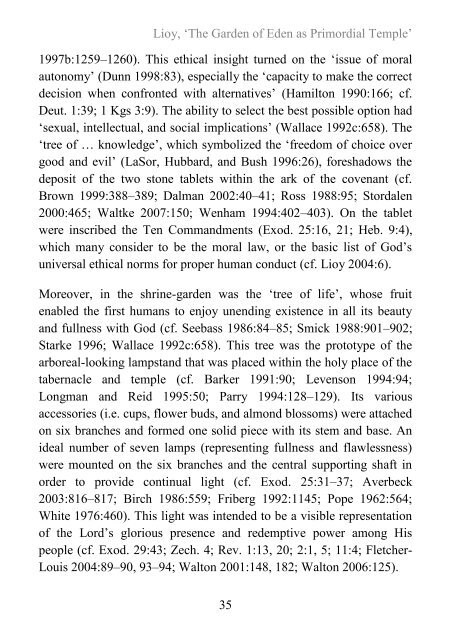Conspectus, vol. 10.pdf - South African Theological Seminary
Conspectus, vol. 10.pdf - South African Theological Seminary
Conspectus, vol. 10.pdf - South African Theological Seminary
Create successful ePaper yourself
Turn your PDF publications into a flip-book with our unique Google optimized e-Paper software.
Lioy, ‘The Garden of Eden as Primordial Temple’<br />
1997b:1259–1260). This ethical insight turned on the ‘issue of moral<br />
autonomy’ (Dunn 1998:83), especially the ‘capacity to make the correct<br />
decision when confronted with alternatives’ (Hamilton 1990:166; cf.<br />
Deut. 1:39; 1 Kgs 3:9). The ability to select the best possible option had<br />
‘sexual, intellectual, and social implications’ (Wallace 1992c:658). The<br />
‘tree of … knowledge’, which symbolized the ‘freedom of choice over<br />
good and evil’ (LaSor, Hubbard, and Bush 1996:26), foreshadows the<br />
deposit of the two stone tablets within the ark of the covenant (cf.<br />
Brown 1999:388–389; Dalman 2002:40–41; Ross 1988:95; Stordalen<br />
2000:465; Waltke 2007:150; Wenham 1994:402–403). On the tablet<br />
were inscribed the Ten Commandments (Exod. 25:16, 21; Heb. 9:4),<br />
which many consider to be the moral law, or the basic list of God’s<br />
universal ethical norms for proper human conduct (cf. Lioy 2004:6).<br />
Moreover, in the shrine-garden was the ‘tree of life’, whose fruit<br />
enabled the first humans to enjoy unending existence in all its beauty<br />
and fullness with God (cf. Seebass 1986:84–85; Smick 1988:901–902;<br />
Starke 1996; Wallace 1992c:658). This tree was the prototype of the<br />
arboreal-looking lampstand that was placed within the holy place of the<br />
tabernacle and temple (cf. Barker 1991:90; Levenson 1994:94;<br />
Longman and Reid 1995:50; Parry 1994:128–129). Its various<br />
accessories (i.e. cups, flower buds, and almond blossoms) were attached<br />
on six branches and formed one solid piece with its stem and base. An<br />
ideal number of seven lamps (representing fullness and flawlessness)<br />
were mounted on the six branches and the central supporting shaft in<br />
order to provide continual light (cf. Exod. 25:31–37; Averbeck<br />
2003:816–817; Birch 1986:559; Friberg 1992:1145; Pope 1962:564;<br />
White 1976:460). This light was intended to be a visible representation<br />
of the Lord’s glorious presence and redemptive power among His<br />
people (cf. Exod. 29:43; Zech. 4; Rev. 1:13, 20; 2:1, 5; 11:4; Fletcher-<br />
Louis 2004:89–90, 93–94; Walton 2001:148, 182; Walton 2006:125).<br />
35

















